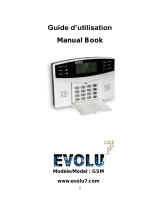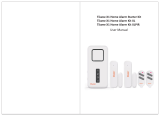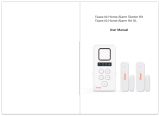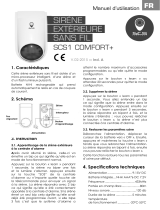Daewoo WIS501S Manuel utilisateur
- Catégorie
- Sirènes
- Taper
- Manuel utilisateur

WIS501S
Indoor Siren
EN
Liz Invest SAS, 6 Rue Léon Morane, 33700, Mérignac, France hereby certifies that
Daewoo Alarm System with CE marking are compliant with the following directive
issued by the Commission of the European Community.
EMC Directive (2014/30/EU) / (2014/53/EU)
The low voltage directive (2014/53/EU)
RED Directive (2014/53/EU)
RoHS Directive (2014/65/EU)
Compliance with these directives implies compliance with the following European
test standards
EN300 328 V2.1.1 ( 2016-11) ;
EN300 220-1 V3.1.1 (2017-2);
EN300 220-2 V3.1.1 ( 2017-02);
EN301 489-1 V2.1.1 ( 2017-02);
EN301 489-17 V3.1.1 ( 2017-02) EN62749:2010
EN62311:2008 EN62368-1:2014+A11: 2017
Authorized representative.
David HADDAD, President.
Date: 18-March-2020
This logo indicates that products, which are no longer in use, should not be thrown
away as household waste. They may contain substances that are harmful to health
and the environment.
Return the product to your reseller or use the recycling collection service provided
by your city.
The Indoor Siren can be used either as an additional siren connected to your alarm
system or as an independent siren connected to a remote control and/or wireless
detectors.
- Wireless connection for an easy installation
- Radio-frequency security of the accessories: more than one million of codes
combinations
Simplified connection to accessories
-
- Can be connected to all of eTiger Secual accessories
- Built-in 3.7V / 300 mAh lithium batteries: 8-hour battery life in standby mode
1 x Indoor Siren
1 x User Manual
Features General information
Power on / o
Siren and light indications
Box Content
Layout
Power Switch
Setting
Connection
The Indoor Siren is powered by its built-in AC 90 ~ 240V plug.
Several Indoor Siren can be installed throughout your home and connected to your
alarm system. When the alarm of your system is triggered, the Indoor Siren rings out
and its LEDs switch on.
The Indoor Siren can also be used as a standalone siren and can be connected to
wireless sensors and/or to a remote control.
Power on
Plug the siren to a AC 90 ~ 220V socket. The light will turn on. You can also turn the
siren on by long pressing (6 seconds) the <Power button> on the siren.
Press the Power button for 6 seconds to turn the siren o.
When arming the system
The LED lights blink red once per second and blue light is switched on.
When arming the system in home mode
The LED lights blink red twice per second and blue light is switched on.
When disarming the system
The blue light is switched on.
Use as an additional siren
Note
Test
Register the Indoor Siren in the control panel
If the siren is used as an additional siren, it must be registered to your alarm’s control
panel. If the alarm is triggered, the sensors and/or to a remote control. will ring out and
its LED lights will turn on.
Press the <Connection> button on the siren. The siren beeps once and the LEDs
light up: the siren is now in Connection Mode for 20 seconds.
Press the “Home” or “Arm” button on the control panel of your alarm system.
Do not trigger an alarm with a sensor when registering the siren in the control panel.
If you have set a delay on your control panel, please temporarely remove the delay
before installing your siren.
Press the “Arm” button on the control panel. Both the built-in siren of the control
panel activate.
Use as a standalone alarm system
Test
Specifications
Clear all accessories and reset
Set the Siren duration
Before using the siren as a standalone alarm system, it must be connected to
a remote control or an accessory (e.g. motion detector, door / window contact).
When the system is armed, if a sensor is triggered, the siren will ring out and the
LED lights will turn on.
Connect a wireless sensor
Press the Connect button on the siren. The siren beeps once and the LEDs light up:
the siren is now in Connection Mode.
Trigger the sensor (e.g. walk in front of the sensor if you want to connect a motion
detector)
You hear one beep: the accessory has been connected to the siren successfully (if
you hear 2 beeps, the accessory has already been connected).
The siren supports up to 10 remote controls and 10 wireless detectors.
Connect a remote control
Press the Connect button on the siren. The siren beeps once and the LEDs light up:
the siren is now in Connection Mode.
Press any button on the remote control.
You hear one beep: the remote control has been connected to the siren
successfully (if you hear 2 beeps, the remote control has already been connected).
a) Test the connection to a remote control
Press the “Arm” button on the remote control. The siren beeps once: the connection
of the remote control is successful. If not, the connection has failed, try registering
the remote control again.
b) Test the connection to a wireless sensor
Arm the system. Trigger the sensor (e.g. walk in front of the sensor if you have
connected a motion detector). The siren rings out: the connection of the sensor is
successful. If not, the connection has failed, try registering the sensor again.
The LEDs blink twice: all the accessories and control panels connected to the siren
Press the Connection button on the siren for 6 seconds until you hear five beeps.
have been cleared.
Short press the <Setting> button to set the siren duration.
Press once to set duration to 1 minute, the siren will beep once. Press twice to
set the duration to 2 minutes, the siren will beep twice. Press 3 times to set the
duration to 3 minutes, the siren will beep 3 times.
Power supply
AC 90 ~ 220V
Volume
90dB
Backup battery
3.7V / 300mA Lithium-Polymer
Static current
< 15mA
Alarm current
< 260mA
Working Distan ce
80m
Radio frequency
433MHz (±75K Hz)
Housing material
ABS plastic
Operating conditions
Temperature: 0°C ~ +55°C
Relative Humidity: ≤80% (non-
condensing)
Dimensions
70 x 70 x 70 mm
WIS501S
Sirène intérieure
EN
Liz Invest SAS, 6 Rue Léon Morane, 33700, Mérignac, France hereby certifies that
Daewoo Alarm System with CE marking are compliant with the following directive
issued by the Commission of the European Community.
EMC Directive (2014/30/EU) / (2014/53/EU)
The low voltage directive (2014/53/EU)
RED Directive (2014/53/EU)
RoHS Directive (2014/65/EU)
Compliance with these directives implies compliance with the following European
test standards
EN300 328 V2.1.1 ( 2016-11) ;
EN300 220-1 V3.1.1 (2017-2);
EN300 220-2 V3.1.1 ( 2017-02);
EN301 489-1 V2.1.1 ( 2017-02);
EN301 489-17 V3.1.1 ( 2017-02) EN62749:2010
EN62311:2008 EN62368-1:2014+A11: 2017
Authorized representative.
David HADDAD, President.
Date: 18-March-2020
This logo indicates that products, which are no longer in use, should not be thrown
away as household waste. They may contain substances that are harmful to health
and the environment.
Return the product to your reseller or use the recycling collection service provided
by your city.
Allumer / éteindre
Fonctionnement
Design
Test
尺寸:640 x 80 mm,折叠后尺寸:80 x 80mm
材质:80克书纸黑白印刷
Caractéristiques
La sirène intérieure peut être utilisée comme une sirène additionnelle connectée
à votre système d’alarme ou comme sirène autonome connectée à un détecteur
et/ou une télécommande.
-
- Sécurité radio-fréquence des accessoires : plus d’un million de combinaisons de
codes
-
- Compatible avec le système d'alarme Daewoo SA501
- Batteries 3.7V /300 mAh au litium : 8 heures d'autonomie en veille
Dans la boîte
1 x Sirène intérieure
1 x Manuel d’utilisateur
Alimentation
Connexion
Réglages
Informations générales
La sirène intérieure est alimentée par sa prise AC 90 ~ 220V intégrée.
Plusieurs sirènes intérieures peuvent être installées chez vous et connectées à votre
système d’alarme. Si une alarme est déclenchée, la sirène intérieure retentit et les
LEDs s’allument.
La sirène intérieure peut également être utilisée comme sirène autonome et être
connectée
Allumer
Branchez la sirène sur une prise AC 90 ~ 220V. La sirène est allumée.
La sirène peut également être allumée en appuyant et maintenant enfoncé le
<bouton d’alimentation> de la sirène pendant 6 secondes.
Éteindre
Appuyez et maintenez enfoncé ce même bouton pendant 6 secondes pour
éteindre la sirène.
Lors de l’armement du système
Les voyants LED clignotent en rouge une fois par seconde et la lumière bleue est
allumée.
Lors de l’armement du système en mode maison
Les voyants LED clignotent en rouge deux fois par seconde et la lumière bleue est
allumée.
Lors du désarmement du système
La lumière bleue est allumée.
Utiliser comme sirène additionnelle
Si la sirène est utilisée comme sirène additionnelle, celle-ci doit être enregistrée
dans le panneau de la centrale d’alarme. Si une alarme est déclenchée, la sirène
intérieure retentit et ses LEDs s’allument.
Enregistrer la sirène WIS501 dans le panneau de la centrale
Appuyez sur le bouton de connexion de la sirène. La sirène émet un bip et ses LEDs
s’allument : la sirène est désormais en mode de connexion.
Appuyez sur le bouton “Maison” ou “Armer” sur le panneau de votre centrale
d’alarme.
Remarque
Ne pas déclencher d’alarme avec un détecteur pendant le processus de connexion
de la sirène à la centrale.
temporairement le délai avant d’installer votre sirène.
Test
Appuyez sur le bouton “Armer” de la centrale. La sirène intégrée au panneau et
la sirène intérieure émettent toutes les deux un bip : la connexion a réussi.
Dans le cas contraire, la connexion a échoué, veuillez recommencer l’opération.
Utiliser comme sirène autonome
Avant d’utiliser la sirène intérieure comme système autonome, celle-ci doit être
connectée à une télécommande ou un détecteur (par ex. un détecteur de
mouvement).
Lorsque le système est armé, si le détecteur est déclenché, la sirène retentit et
Connecter une télécommande
Appuyez sur le bouton de connexion de la sirène. La sirène émet un bip et ses LEDs
s’allument : la sirène est désormais en mode de connexion.
Appuyez sur une des touches de la télécommande.
Vous entendez un bip : la télécommande a bien été connectée à la sirène (si vous
entendez 2 bips, la télécommande a déjà été connectée).
Connecter un accessoire
Appuyez sur le bouton de connexion de la sirène. La sirène émet un bip et ses LEDs
s’allument : la sirène est désormais en mode de connexion.
Déclenchez l’accessoire (par exemple marchez devant le détecteur si vous tentez
de connecter un détecteur de mouvement).
Vous entendez un bip : l’accessoire a bien été connecté à la sirène (si vous entendez
2 bips, celui-ci a déjà été connecté).
les Leds s'allument.
a) Tester la connexion à la télécommande
Appuyez sur le bouton “Armer” de la télécommande. La sirène émet un bip : la
télécommande est bien connectée. Dans le cas contraire, la connexion a échoué,
veuillez recommencer le processus de connexion.
Armez le système. Déclenchez un détecteur (par exemple marchez devant le
détecteur si vous avez connecté un détecteur de mouvement). La sirène retentit : le
détecteur est bien connecté. Dans le cas contraire, la connexion a échoué, veuillez
recommencer le processus de connexion.
Appuyez et maintenez enfoncé le bouton de connexion sur la sirène pendant 6
secondes, jusqu’à ce que vous entendiez cinq bips. Les LEDs clignotent deux fois :
Réglez la durée de la sirène
Appuyez brièvement sur le bouton "réglages" pour définir la durée de la sirène.
Appuyez une fois pour régler la durée à 1 minute, la sirène bipera une fois. Appuyez
deux fois pour régler la durée sur 2 minutes, la sirène bipera deux fois. Appuyez 3
fois pour régler la durée sur 3 minutes, la sirène bipera 3 fois.
Alimentation
AC 90 ~ 220V
Volume
90dB
Batterie de secours
3.7V / 300mA Lithium
Courant (veille)
< 15mA
Courant (fonctionnement)
< 260mA
Portée
80m en champs libre
Fréquence radio
433MHz (±75KHz)
Boîtier
Plastique ABS
Conditions d’utilisation
Température : -10°C ~ +55°C
Humidité : ≤80% (sans condensation)
Dimensions
70 x 70 x 70 mm
-
 1
1
Daewoo WIS501S Manuel utilisateur
- Catégorie
- Sirènes
- Taper
- Manuel utilisateur
dans d''autres langues
- English: Daewoo WIS501S User manual
Documents connexes
Autres documents
-
DENVER® ASA-30 Manuel utilisateur
-
Chacon 34956 Manuel utilisateur
-
 Evolu7 GSM Manual Book
Evolu7 GSM Manual Book
-
 Tiiwee X1 XL Manuel utilisateur
Tiiwee X1 XL Manuel utilisateur
-
 Tiiwee X3 Home Alarm Kit XL Manuel utilisateur
Tiiwee X3 Home Alarm Kit XL Manuel utilisateur
-
Smanos G310 Le manuel du propriétaire
-
Smanos W020 Manuel utilisateur
-
Audiovox Prestige Platinum APS 600 Manuel utilisateur
-
 SCS Sentinel SAL0042 Le manuel du propriétaire
SCS Sentinel SAL0042 Le manuel du propriétaire




